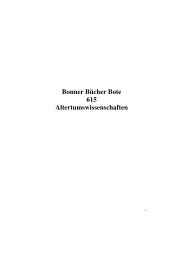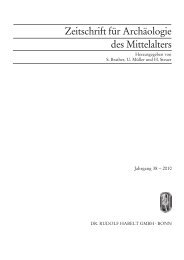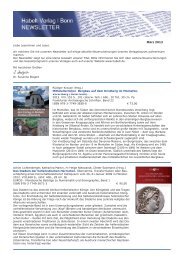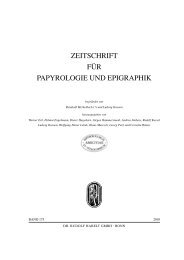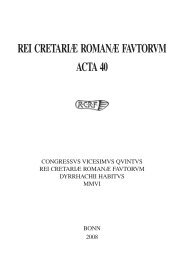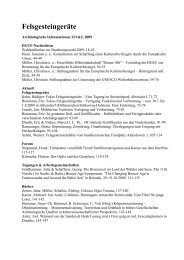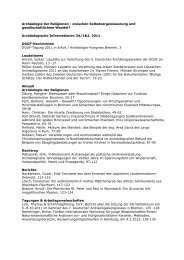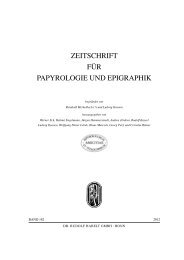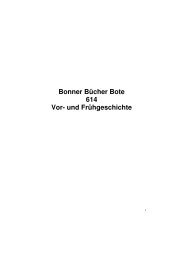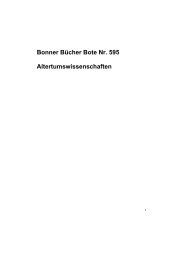rei cretariæ romanæ favtorvm acta 41 - Dr. Rudolf Habelt GmbH
rei cretariæ romanæ favtorvm acta 41 - Dr. Rudolf Habelt GmbH
rei cretariæ romanæ favtorvm acta 41 - Dr. Rudolf Habelt GmbH
You also want an ePaper? Increase the reach of your titles
YUMPU automatically turns print PDFs into web optimized ePapers that Google loves.
COLIN M. WELLS<br />
Will discussing amphoras as economic indicators, plus our<br />
Honorary Member Anna Marguerite McCann in a 50-page<br />
article on the significance of the port of Cosa, Philip Kenrick<br />
on trade patterns at Berenice, Kathleen Slane on Italian TS<br />
imports at Corinth and many others. This was a wholly laudable<br />
attempt to set pottery studies in a much wider social<br />
and economic context.<br />
With the next three volumes of the Acta, however, we are<br />
back to the predominance of TS: these are volumes 27/28<br />
(1990), from the 15 th Congress at Worms in 1986, with our<br />
Honorary Member Gerwulf Schneider reporting on the chemical<br />
analysis of pottery from the middle Rhine; 29/30 (1991),<br />
from the 16 th at Pleven; and 31/32 (1992), from the 17 th at<br />
Pavia in 1990. Worms (1986) was the Congresses at which<br />
the project of a new Conspectus of sigillata types was discussed,<br />
Pavia (1990) where the resulting publication was unveiled.<br />
For those of us who worked on it in the intervening<br />
years, it was a wonderful collegial experience. Elisabeth was<br />
our leader, Howard present on occasion in the background,<br />
available for consultation. As for the Pavia Congress, the Acta<br />
contain a substantial article by me on “Pottery manufacture<br />
and military supply north of the Alps”, but I have no recollection<br />
of the Congress and I am sure I have never even been to<br />
Pavia! I assume that someone read it for me, as happened at<br />
the Ephesus/Pergamum Congress, or that it was not actually<br />
given at the Congress, but still included in the proceedings.<br />
Henceforth TS is destined to play a lesser role in our proceedings.<br />
The next Congress was the 18 th , at Szekesfehervar<br />
in 1992, but the Acta were delayed and appeared as volume<br />
34 (1995), while conversely volume 33 (1996) contained<br />
the papers from the 19 th Congress at Timisoara. Volume 33<br />
was the first produced by a new editor, Susanne Zabehlicky-<br />
Scheffenegger, who continued in office until volume 39 and<br />
achieved a professional standard for which we are all grateful.<br />
The volumes took on the larger format with which we<br />
are familiar. Volume 33 comprised 22 articles, of which 6<br />
were on lamps, 1 on amphoras, and only 2 specifically on<br />
TS. An innovation was the list of 15 papers given at the<br />
Congress but for one or another reason not included in the<br />
Acta. The main themes of the Congress are defined as provincial<br />
centres of production, lamps, mortaria, and interdisciplinary<br />
research on pottery. Volume 34, edited and published in<br />
Hungary, devotes 16 out of 33 articles to lead-glazed wares and<br />
only 6 to TS. An article by Vivien Swan deducing the presence<br />
of soldiers from Africa in garrison with the legio VI victrix at<br />
York in the early 3 rd century from the shape of their cooking<br />
pots is a model of observation and deduction. As for TS, are its<br />
problems thought to have been largely solved after nearly 40<br />
years in the forefront of pottery research, or has a new generation<br />
of Fautores simply broadened its interests?<br />
Succeeding volumes from 35 onwards <strong>rei</strong>nforce this new<br />
pattern. Volume 35 for instance, from the 20 th Congress at<br />
York and Newcastle, contains 35 articles divided into five<br />
sections: pottery and the Roman army (9 articles), cooking<br />
ware (8), pottery manufacturing sites (6), sigillata and fine<br />
wares (8), and various (4). The first three of these were defined<br />
as the principal themes of the Congress. There were<br />
another 27 papers or poster sessions not published. The long<br />
<strong>rei</strong>gn of TS appears to be over, and a detailed analysis of the<br />
contents of the subsequent Acta would confirm it. Of particular<br />
interest is the 21 st Congress at Ephesus and Pergamum,<br />
the only one so far held outside Europe, which emphasised<br />
the Eastern provinces and East-West exchanges, a<br />
total of 39 articles, with a further 11 on the Danube and the<br />
Balkans, whereas there were only 5 on Italian TS. I still<br />
deeply regret having had to miss this Congress because it<br />
clashed with my teaching duties in Texas. Fautores teaching<br />
in North America, where the university year generally starts<br />
in August or September, often have this problem.<br />
Two years later, for the 22 nd Congress at Lyon, as one<br />
might expect, the West comes back to prominence. A dozen<br />
articles on Gaulish sites or productions include an invaluable<br />
mise-au-point by Armand Desbat on the Lyon workshops,<br />
culminating in a bibliography of 79 items. The 23 rd<br />
Congress at Rome produced, naturally enough, 20 papers<br />
on Rome and Italy. The 24 th at Namur and Louvain had as<br />
its major theme Late Antiquity and the 25 th at Dürres the<br />
pottery of the Via Egnatia. Dürres was notable for the magnificent<br />
job of organisation that our Albanian colleagues did<br />
in sometimes difficult circumstances, and for the number of<br />
younger scholars participating.<br />
It now seems to be accepted that an emphasis on the<br />
pottery of the region where the Congress is being held is<br />
natural and appropriate, and what is to be seen in local sites<br />
and museums may suggest other specific themes, just as the<br />
present Congress at Cadiz has for its main theme kiln sites<br />
and pottery manufacture, a topic that, as far as my memory<br />
goes, has not had much prominence since the 1977 Congress<br />
at Metz and Nancy, when we visited Rheinzabern. The<br />
next Congress will be in Belgrade, and provisional invitations<br />
for subsequent years look like taking us to other countries<br />
where we have never met before. We cannot however<br />
go anywhere unless invited, and there is no immediate prospect<br />
of meeting again outside Europe, where we have met<br />
only once in a half century. It is particularly regrettable that<br />
we have never met in North Africa, despite the role that that<br />
area played in the ceramic history of the Roman Empire.<br />
One would scarcely think that Africa produced any pottery,<br />
to judge the pitiful scarcity of papers in the Acta on sites<br />
and productions in Africa over the years.<br />
VIII



